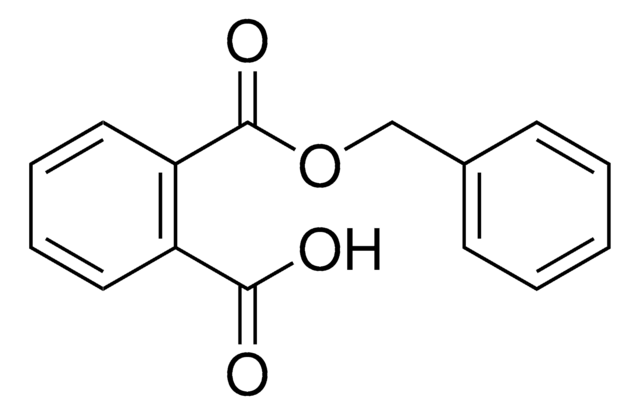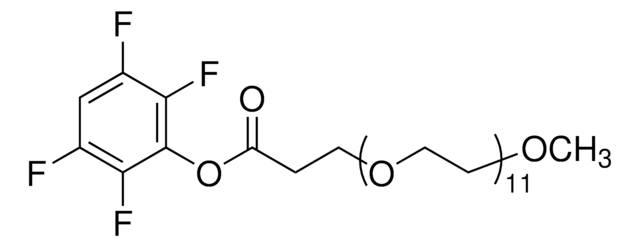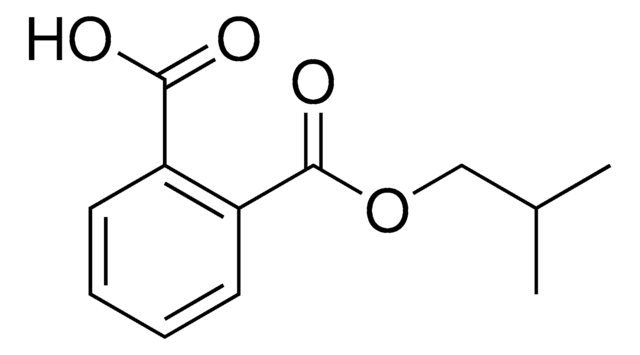SMB00941
Monoethyl Phthalate
≥95%
Synonym(s):
Monoethyl Phthalate, 1,2-Benzenedicarboxylic acid, monoethyl ester, Ethyl 2-carboxybenzoate
Sign Into View Organizational & Contract Pricing
All Photos(1)
About This Item
Empirical Formula (Hill Notation):
C10H10O4
CAS Number:
Molecular Weight:
194.18
UNSPSC Code:
12352202
NACRES:
NA.77
Recommended Products
Quality Level
Assay
≥95%
form
powder
color
white
storage temp.
2-8°C
InChI
1S/C10H10O4/c1-2-14-10(13)8-6-4-3-5-7(8)9(11)12/h3-6H,2H2,1H3,(H,11,12)
InChI key
YWWHKOHZGJFMIE-UHFFFAOYSA-N
General description
Monoethyl Phthalate (MEP) is a metabolite of plasticizer diethyl phthalate (DEP). Monoethyl Phthalate is a one of the most abundant phthalate metabolites present in human urine. It is also present in other body fluids including breast milk, serum, semen, saliva and amniotic. Monoethyl Phthalate (MEP), together with mono-benzyl phthalate and mono-isobutyl phthalate has been associated with obesity in children, anomalities in pubertal development in girls, and increased risk of endometriosis in women. MEP and MiBP (mono-isobutyl phthalate) representing low molecular weight phthalates, and MECPP (Mono-(2-ethyl-5-carboxypentyl) phthalate) and MCiOP (Mono-(carboxyisooctyl) phthalate) representing high molecular weight phthalates have been used as indicators of phthalate exposure.
Application
Metabolomics, Microbiome
Other Notes
For additional information on our range of Biochemicals, please complete this form.
Storage Class Code
11 - Combustible Solids
WGK
WGK 3
Choose from one of the most recent versions:
Certificates of Analysis (COA)
Lot/Batch Number
Don't see the Right Version?
If you require a particular version, you can look up a specific certificate by the Lot or Batch number.
Already Own This Product?
Find documentation for the products that you have recently purchased in the Document Library.
Jessica Shoaff et al.
Environmental health perspectives, 125(9), 097008-097008 (2017-09-25)
Early-life phthalate exposure may influence child adiposity, but prior studies have not determined if there are periods of enhanced vulnerability to phthalates. To examine the relationship between child adiposity at 8 y of age and repeated urinary biomarkers of phthalate
Yu Wang et al.
Toxics, 7(2) (2019-04-10)
Phthalates (diesters of phthalic acid) are widely used as plasticizers and additives in many consumer products. Laboratory animal studies have reported the endocrine-disrupting and reproductive effects of phthalates, and human exposure to this class of chemicals is a concern. Several
Mandy Fisher et al.
Environmental science & technology, 53(18), 10813-10826 (2019-08-20)
Phthalates and bisphenol A (BPA) are used in some personal care products (PCPs) and containers for food processing and packaging. The Plastics and Personal-Care Product use in Pregnancy (P4) Study (2009-10) explored the association between PCP use during pregnancy and
Our team of scientists has experience in all areas of research including Life Science, Material Science, Chemical Synthesis, Chromatography, Analytical and many others.
Contact Technical Service




![mono-[(2RS)-2-Ethyl-5-oxohexyl] phthalate analytical standard](/deepweb/assets/sigmaaldrich/product/structures/380/975/47f8fcbc-594c-4f9c-84df-43685552cd06/640/47f8fcbc-594c-4f9c-84df-43685552cd06.png)


